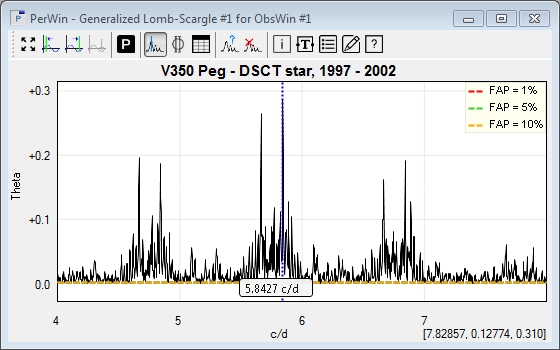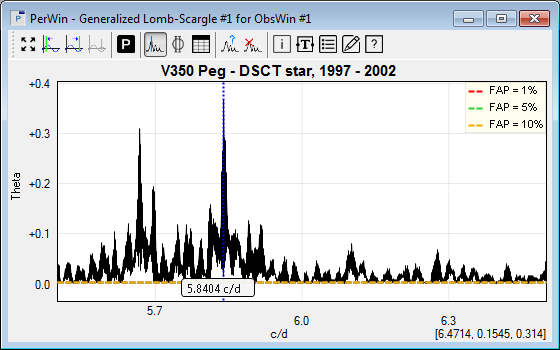- We explained in Tutorial 2 that visual inspection of a light curve is an essential step to get a first estimate of a possible period in the observations. Your ObsWin still displays the last ObsSet of the light curve, which we have just added to the ObsWin.
Click Zoom on previous ObsSet in the Navigation buttons  of the ObsWin toolbar. This brings up the one but last ObsSet, which contains two distinct maxima, sufficient to obtain the required estimate. Move the mouse close to an observation at the top of the first maximum and note down the Julian Date value you see in the mouse coordinates. Then move the mouse close to an observation at the top of the second maximum and do the same. of the ObsWin toolbar. This brings up the one but last ObsSet, which contains two distinct maxima, sufficient to obtain the required estimate. Move the mouse close to an observation at the top of the first maximum and note down the Julian Date value you see in the mouse coordinates. Then move the mouse close to an observation at the top of the second maximum and do the same.
If you subtract both values, you will obtain a difference that is approximately 0.17 d or 1 / 0.17 = 5.78 c/d. We will use this value as an initial approximation for the period determination further on in this tutorial. Alternatively, you can use the Measurement indicator to measure the distance between both maxima, which is more convenient.
- Click on the Period Determination button
 in the ObsWin toolbar to display the Period determination box. In the Methods section, select Lomb-Scargle GLS (the Generalized Lomb-Scargle method). We know from the above visual inspection that the expected period of V350 Peg is around 5.78 c/d. Select Days as Base and select Frequency as Unit. Enter 4 in the Start field, and 8 in the End field of the Period section. Enter 1500 in the Steps field. Click Apply to start the Lomb-Scargle GLS calculations. in the ObsWin toolbar to display the Period determination box. In the Methods section, select Lomb-Scargle GLS (the Generalized Lomb-Scargle method). We know from the above visual inspection that the expected period of V350 Peg is around 5.78 c/d. Select Days as Base and select Frequency as Unit. Enter 4 in the Start field, and 8 in the End field of the Period section. Enter 1500 in the Steps field. Click Apply to start the Lomb-Scargle GLS calculations.

- This creates a Period Window (PerWin) with a dominant period at 5.843 c/d, which confirms that our visual inspection approach has resulted in a good starting value.

- To improve the accuracy of the dominant period, we will refine the period analysis by narrowing the period scan range (Start-End) and by increasing the scan resolution (Steps). Select Refine period analysis in the Period analysis menu (or click on the Period Detremination button in the PerWin Toolbar) to display the Lomb-Scargle GLS Period determination box. Enter a start value of 5.5, an end value of 6.5, and a steps value of 2500. Then click Apply to start the period calculations.
- This creates a new PerWin with a dominant period at 5.840 c/d. This value is in very good agreement with the published value of 5.839 c/d.

|